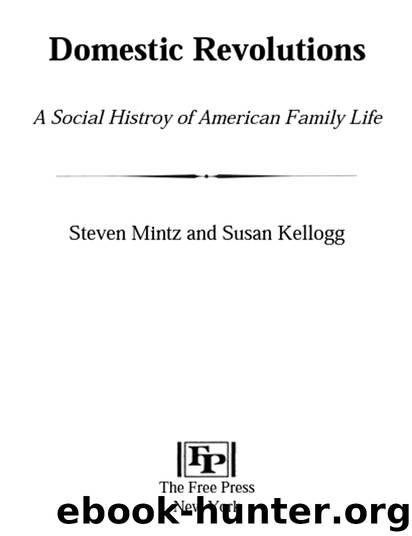Domestic Revolutions by Susan Kellogg

Author:Susan Kellogg
Language: eng
Format: epub
Publisher: THE FREE PRESS
Published: 1988-07-15T00:00:00+00:00
A family picnics outside their new 1949 Ford station wagon. Courtesy of the collections of Henry Ford Museum and Greenfield Village.
CHAPTER IX
The Golden Age: Families of the 1950s
AT the end of her first year as a psychology graduate student at the University of California at Berkeley in 1944, Betty Naomi Goldstein was confronted with a choice that would change her life. She was offered a large fellowship that would support her through a doctorate, but her boyfriend demanded that she turn it down. “You can take that fellowship,” she remembered him saying, “but you know I’ll never get one like it. You know what it will do to us.” Betty was faced with a serious dilemma: “Either I pursue my career or I sublimate my wishes to a man.” Fearful of “becoming an old maid college teacher,” she turned down the fellowship. Despite her sacrifice, the romance did not last. 1
Betty subsequently moved to Greenwich Village, where she supported herself as a journalist. There she met Carl Friedan, a product of summer stock theater, and fell in love. Two months after their first date he moved into her apartment, and in 1947, after a whirlwind seven-month courtship, they married. Like thousands of other women, she gave birth, in rapid succession, to three children. And like many other post-war families, the Friedans moved from an apartment project to a house in the suburbs, overlooking the Hudson River. Betty continued to free-lance four or five articles a year for women’s magazines, but she felt freakish for having a career and worried that she was neglecting her children. She devoted most of her time to child-care and entertaining, and on her census form, she listed her occupation as “housewife.” 2
In her decision to forego professional training and the pursuit of a professional career and devote her energies to child-rearing and homemaking, Betty Friedan was by no means alone. After the war many women who had joined the work force returned to being housewives. Managing a home in the suburbs and raising a family became the goal of most women during the 1950s.
To a generation economically strapped in the depression and sacrificing for the war effort in World War II, the opportunity to have a family and buy a suburban house, with a backyard barbecue and a living room teeming with children, filled a deep emotional need. For two decades American families had experienced unprecedented strain, and now they turned away from public concerns and sought in private life satisfactions available nowhere else. For those who could personally recall their family’s struggle to make ends meet during the depression, and who, during the war, had experienced family separation, frequent movement from place to place, and anxiety about men and women fighting overseas, a house of their own and family togetherness was a promise of security and fulfillment. By “marrying at an earlier age, rearing larger families,” and owning their own homes, young adults of the 1950s could, in the words of McCall’s magazine, find their “deepest satisfaction.
Download
This site does not store any files on its server. We only index and link to content provided by other sites. Please contact the content providers to delete copyright contents if any and email us, we'll remove relevant links or contents immediately.
| Anthropology | Archaeology |
| Philosophy | Politics & Government |
| Social Sciences | Sociology |
| Women's Studies |
Cecilia; Or, Memoirs of an Heiress — Volume 1 by Fanny Burney(32073)
Cecilia; Or, Memoirs of an Heiress — Volume 3 by Fanny Burney(31468)
Cecilia; Or, Memoirs of an Heiress — Volume 2 by Fanny Burney(31418)
The Great Music City by Andrea Baker(30795)
We're Going to Need More Wine by Gabrielle Union(18641)
All the Missing Girls by Megan Miranda(14784)
Pimp by Iceberg Slim(13797)
Bombshells: Glamour Girls of a Lifetime by Sullivan Steve(13698)
Fifty Shades Freed by E L James(12923)
Talking to Strangers by Malcolm Gladwell(12888)
Norse Mythology by Gaiman Neil(12858)
For the Love of Europe by Rick Steves(11552)
Crazy Rich Asians by Kevin Kwan(8897)
Mindhunter: Inside the FBI's Elite Serial Crime Unit by John E. Douglas & Mark Olshaker(8718)
The Lost Art of Listening by Michael P. Nichols(7169)
Enlightenment Now: The Case for Reason, Science, Humanism, and Progress by Steven Pinker(6879)
The Four Agreements by Don Miguel Ruiz(6324)
Bad Blood by John Carreyrou(6284)
Weapons of Math Destruction by Cathy O'Neil(5844)
